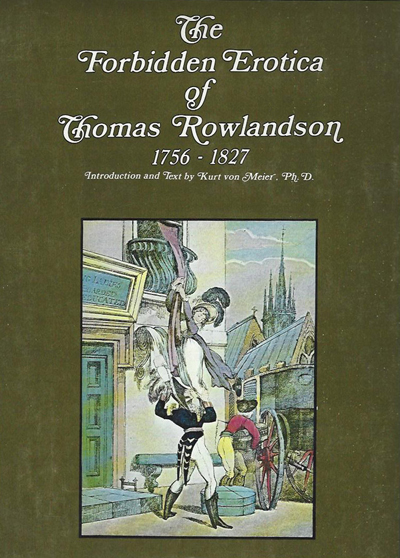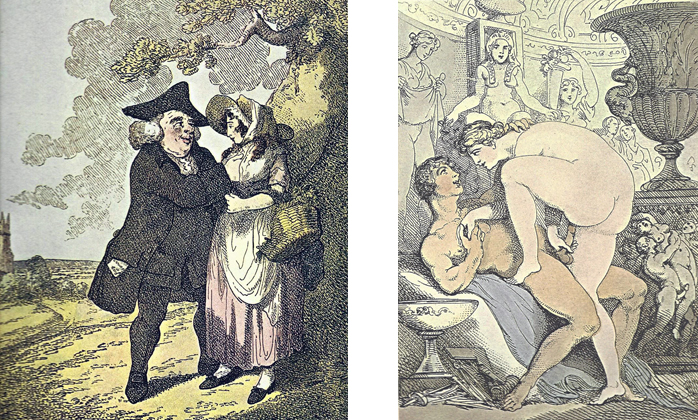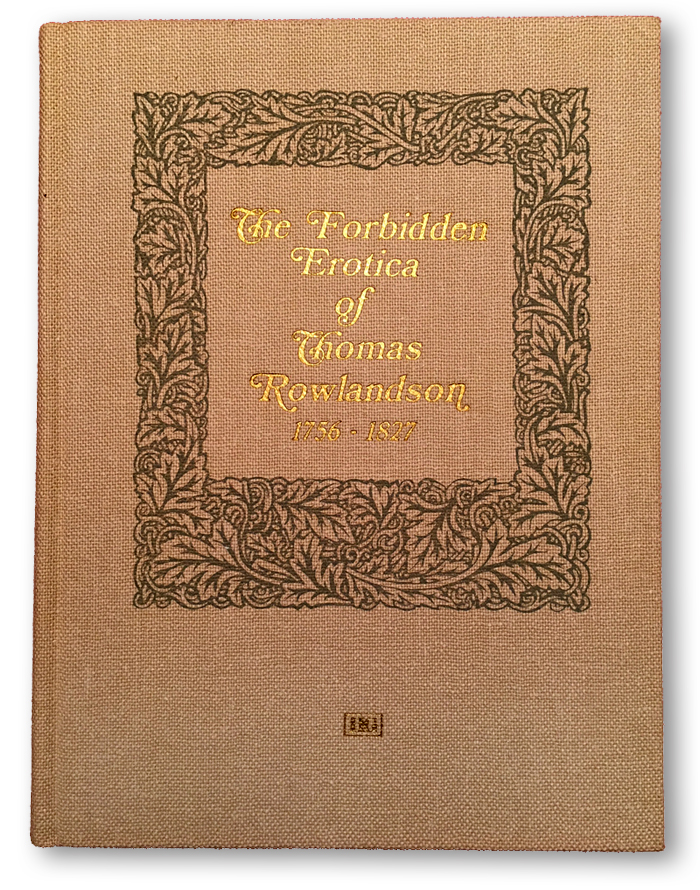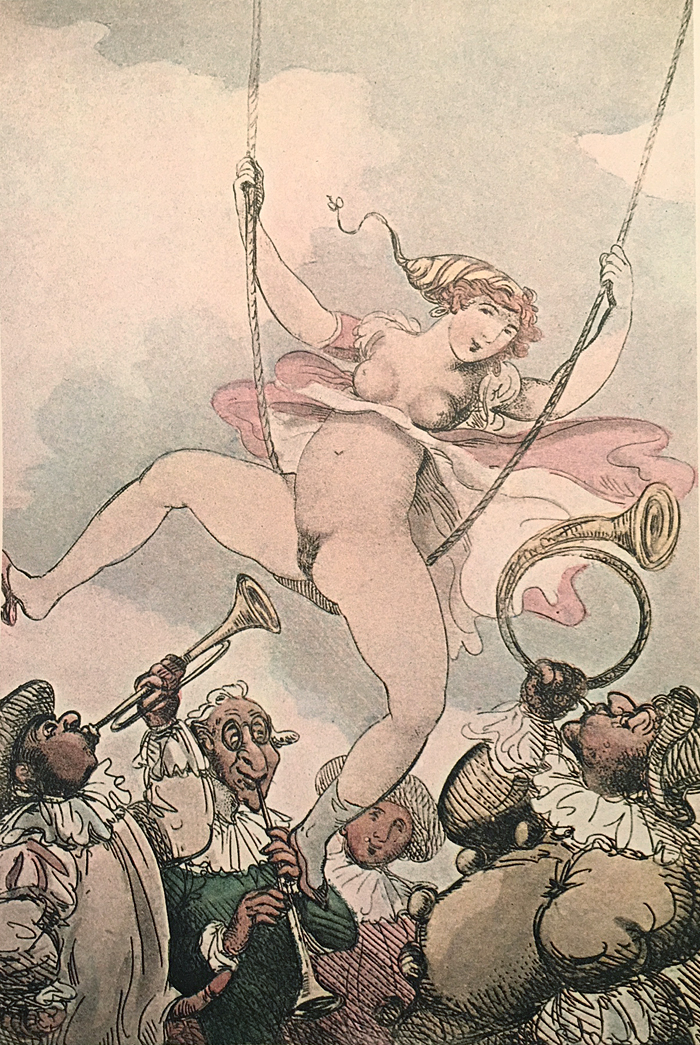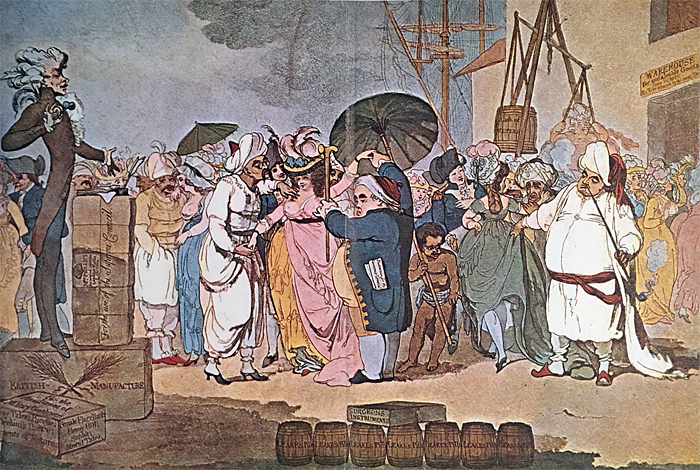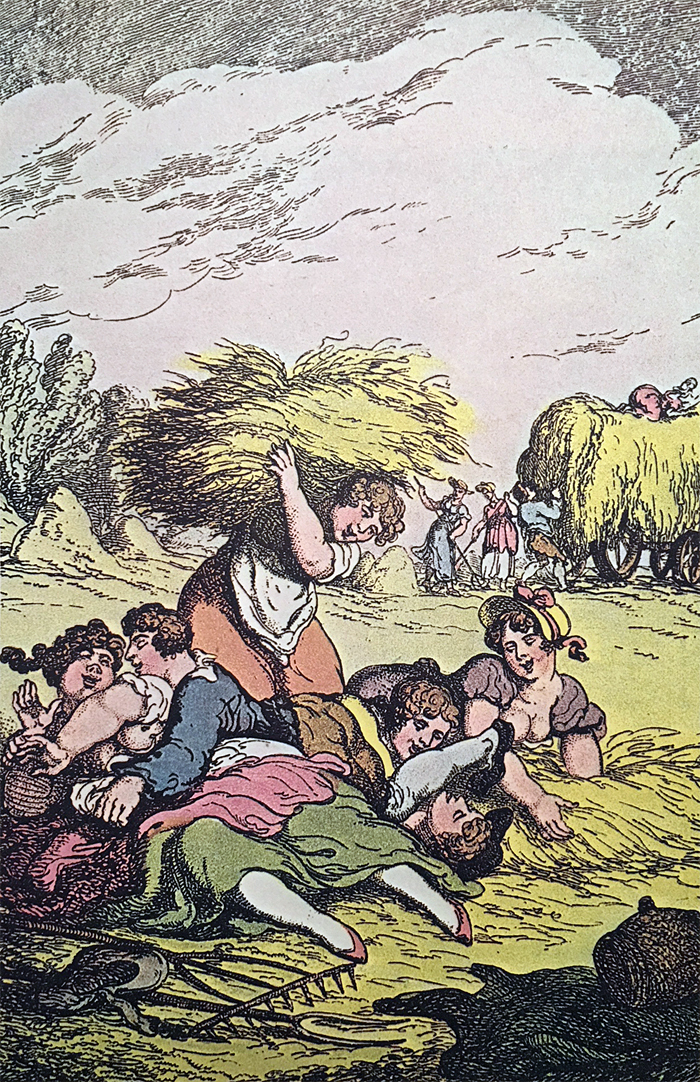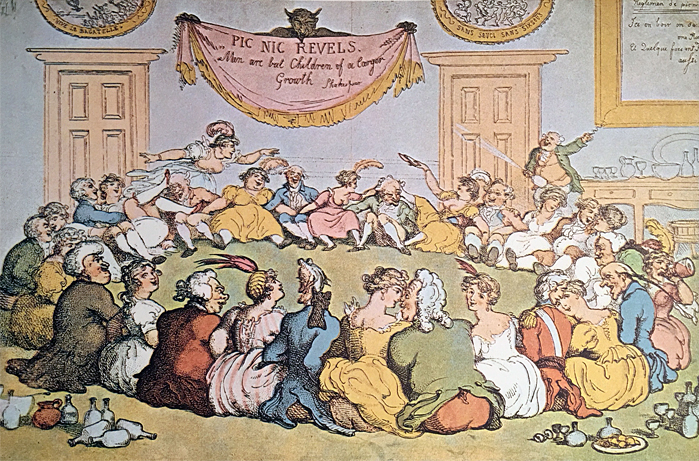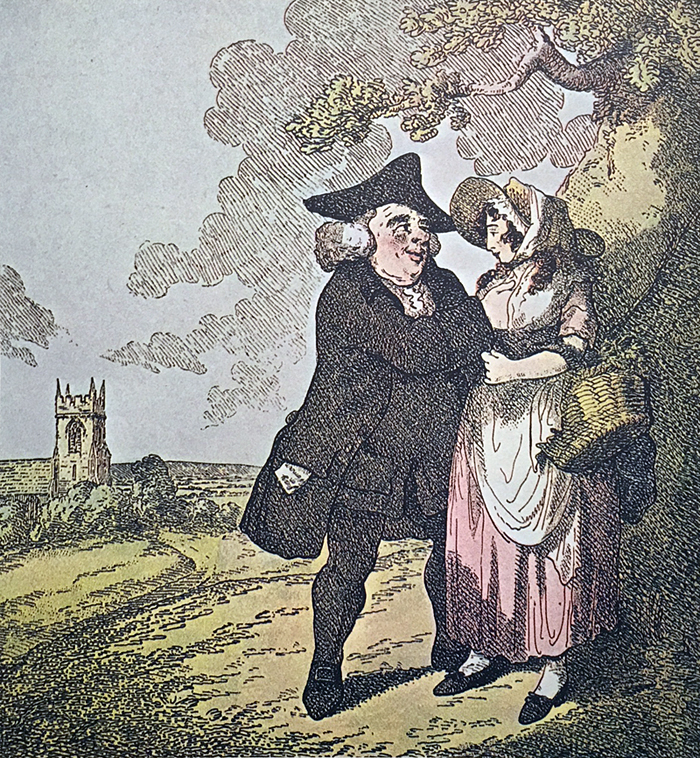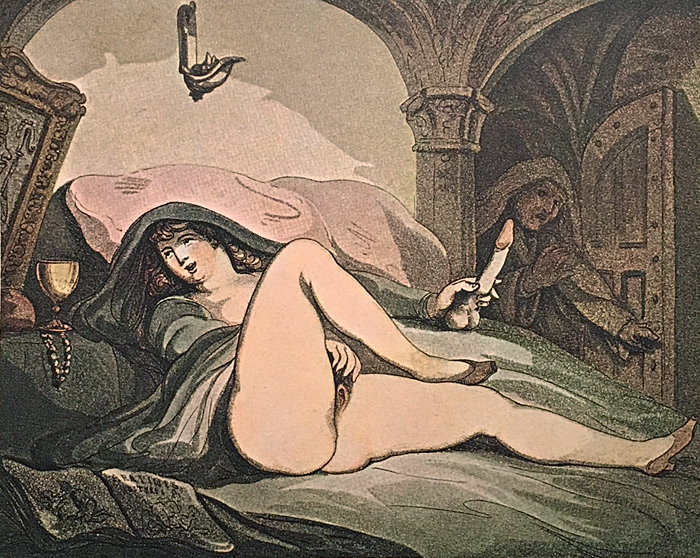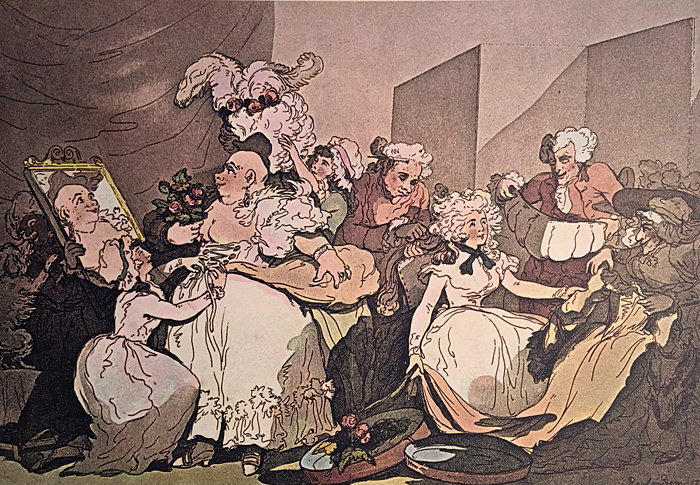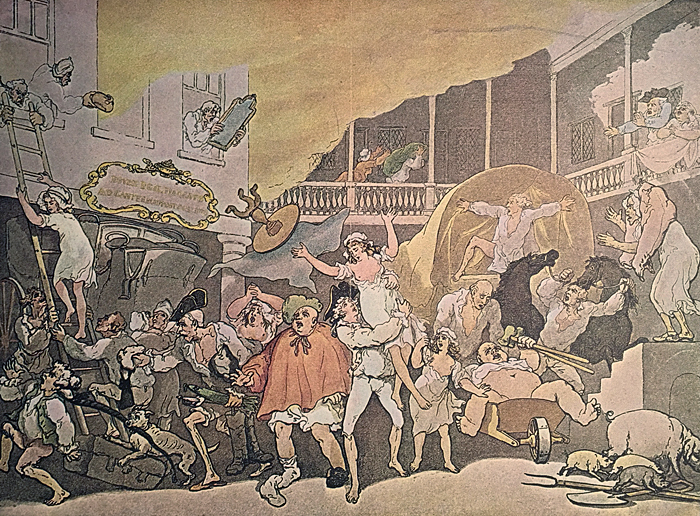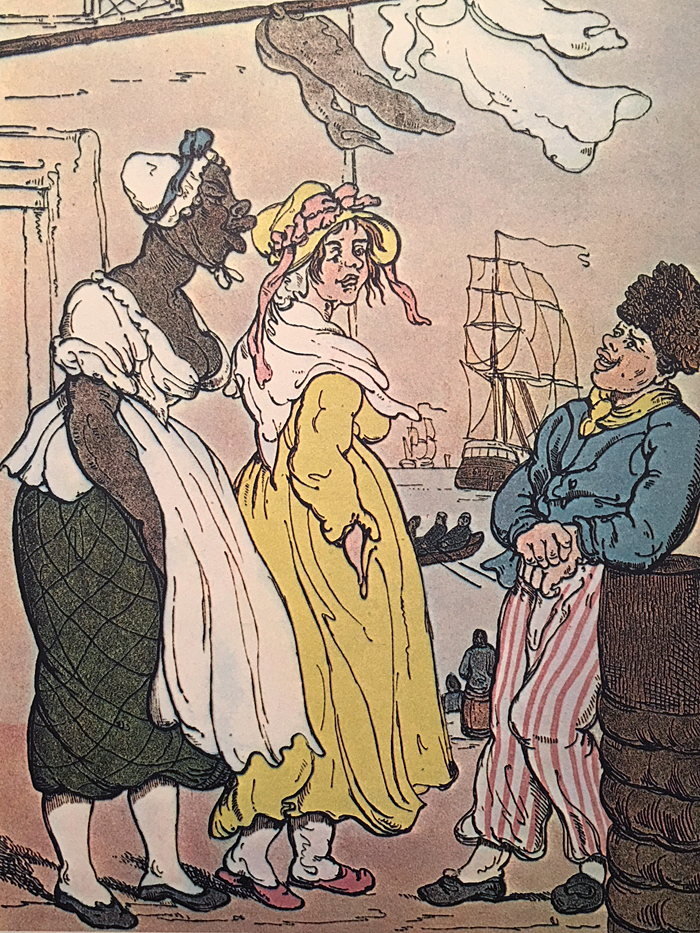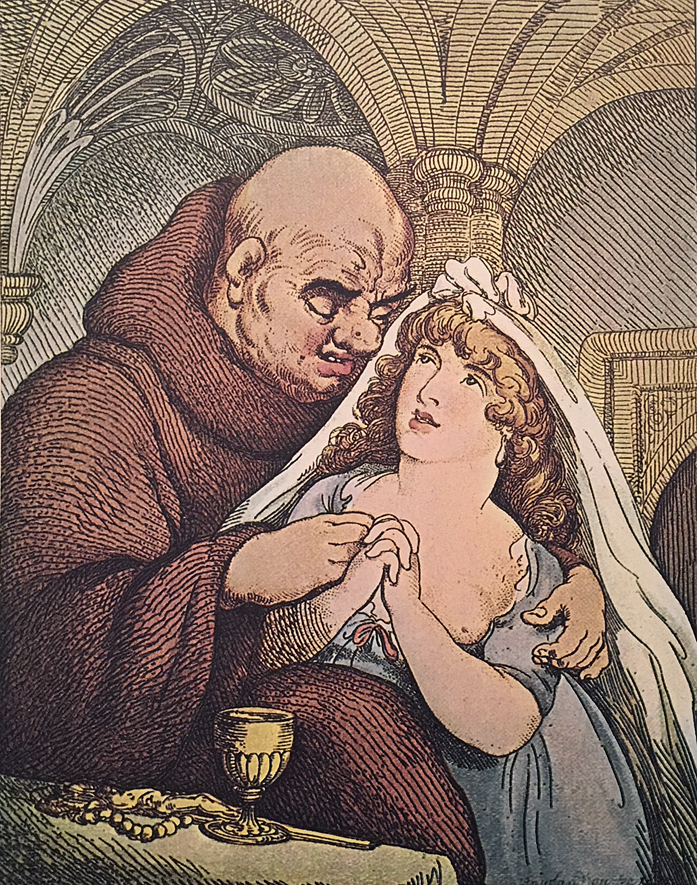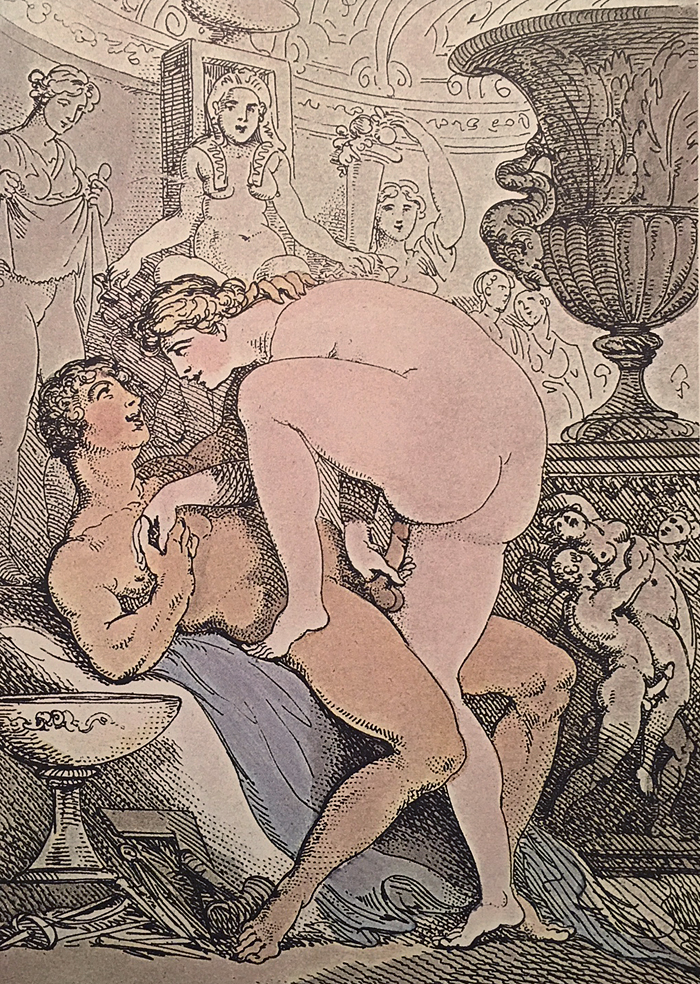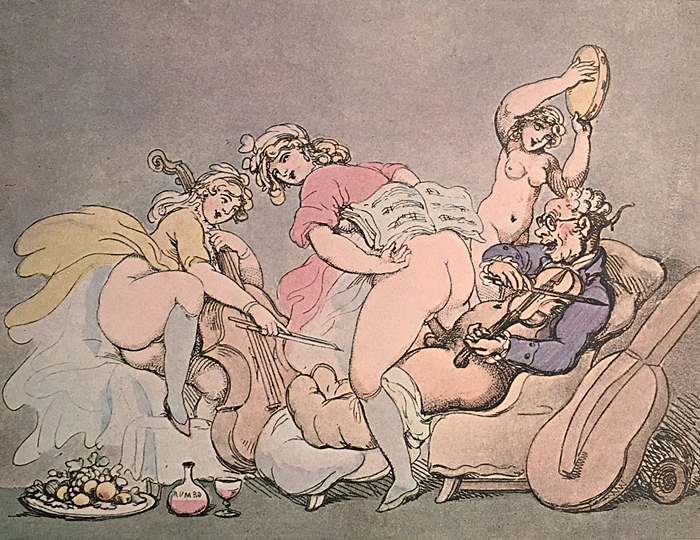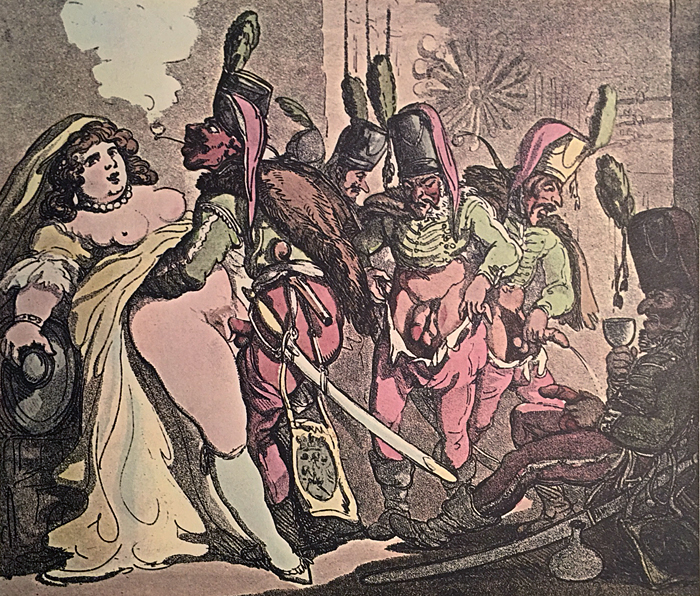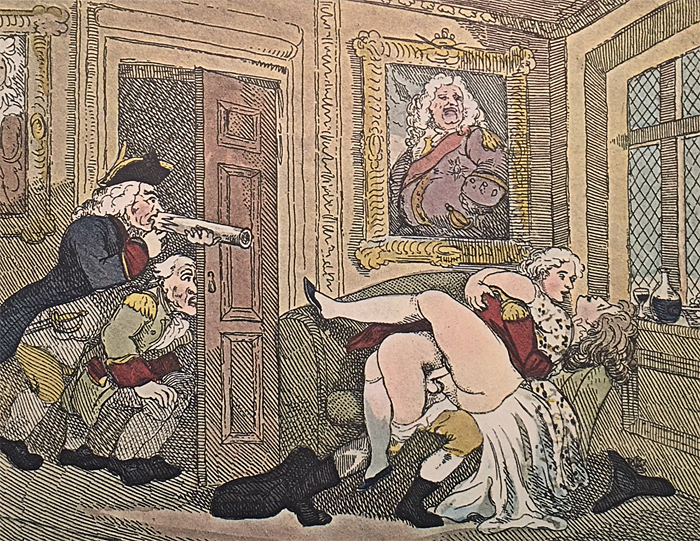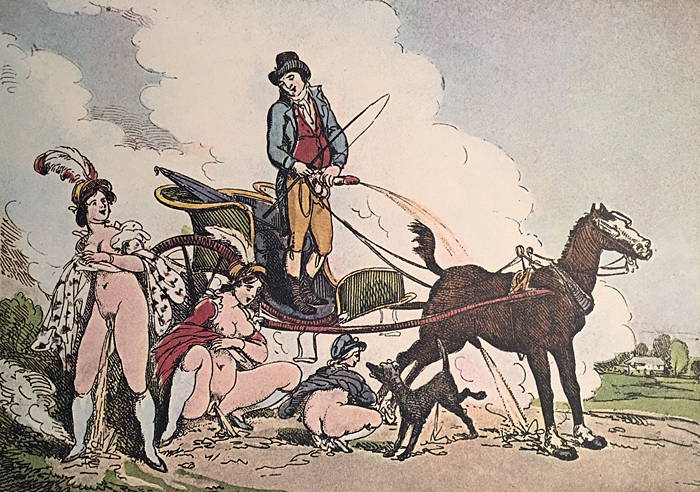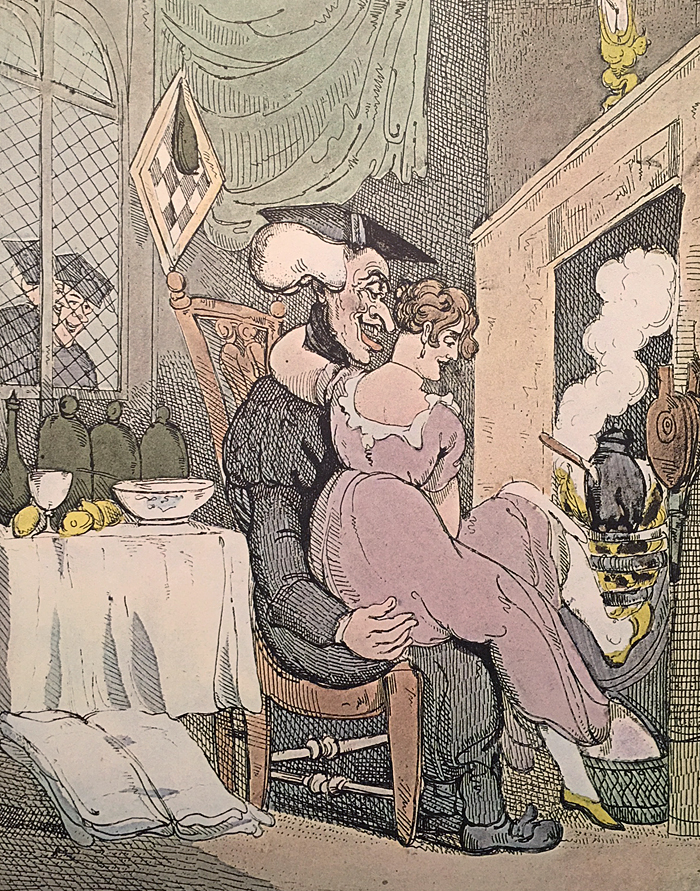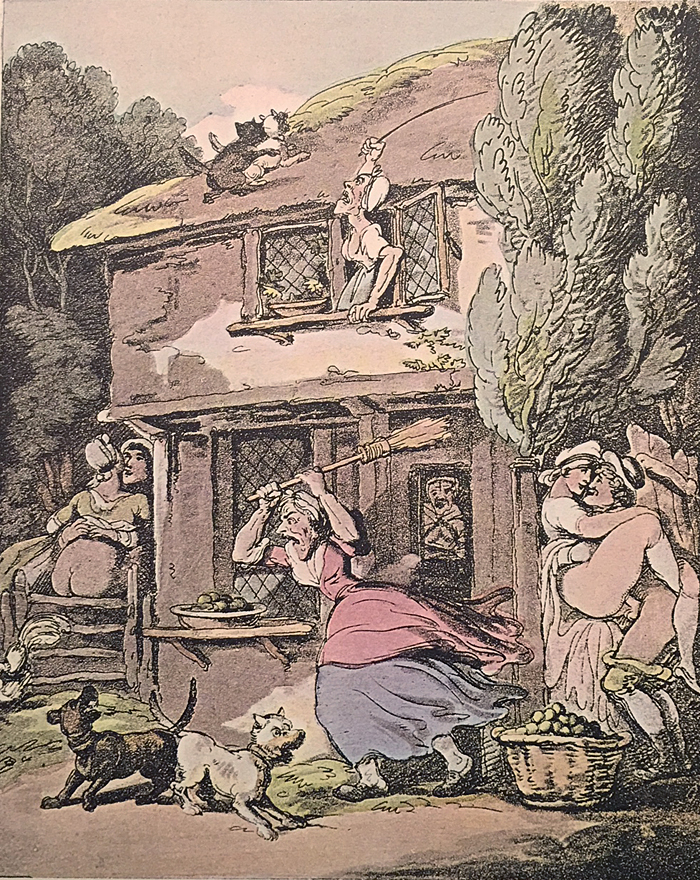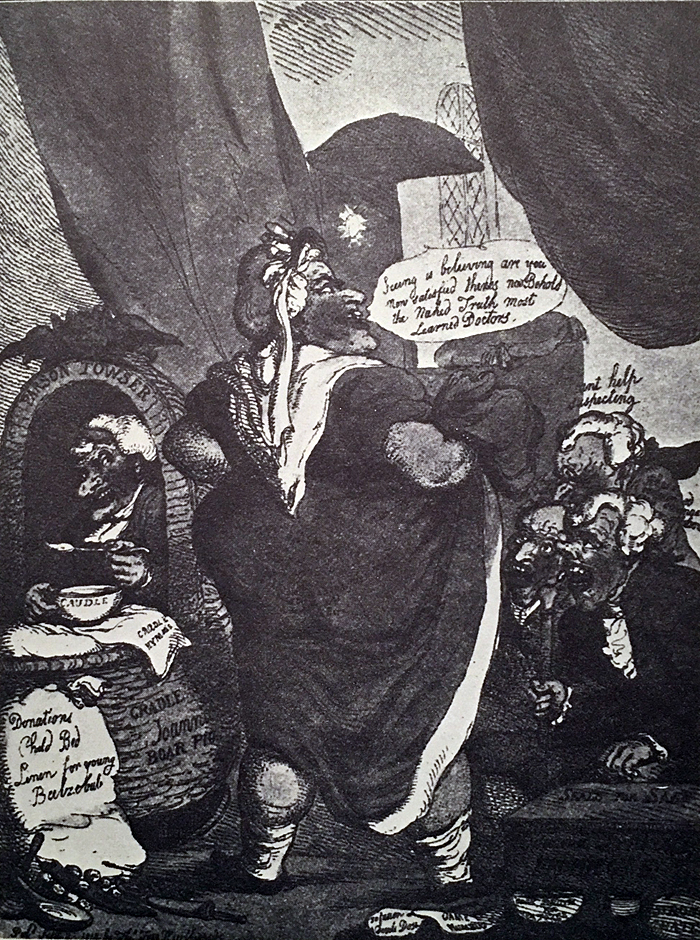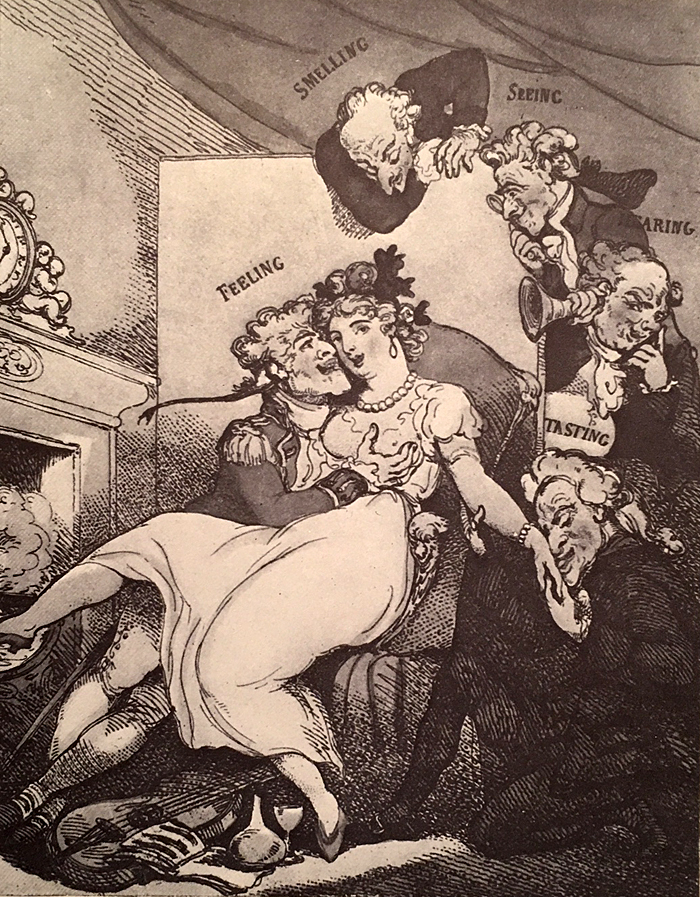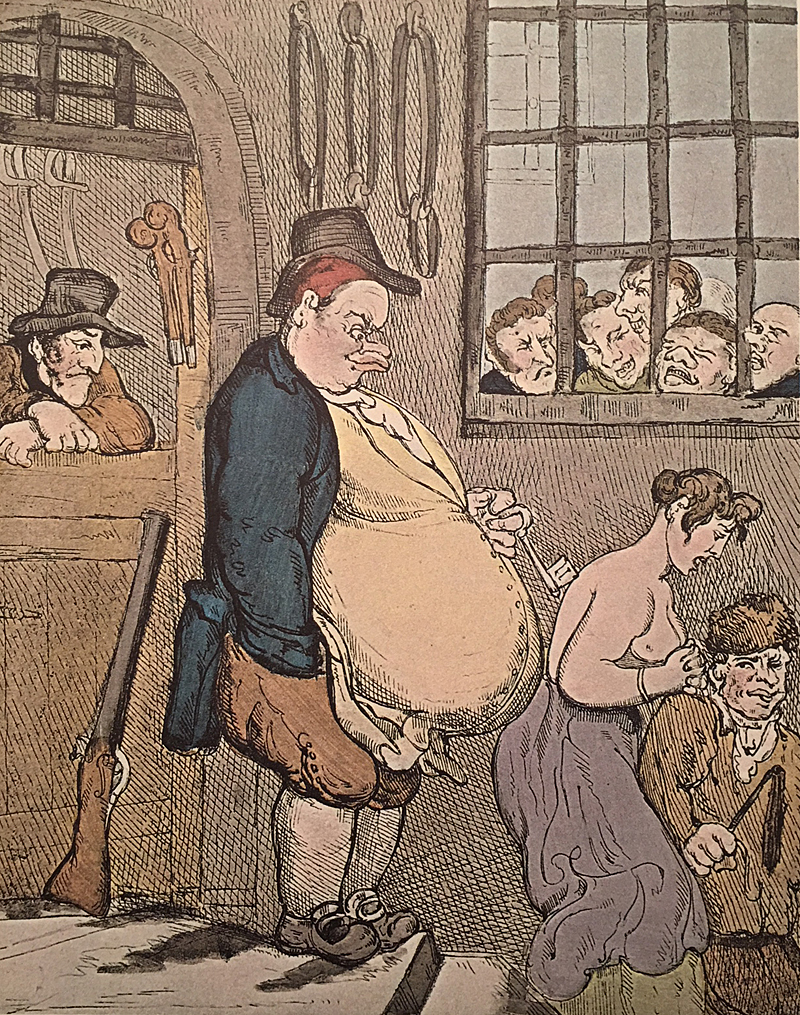The Forbidden Erotica of Thomas Rowlandson
1756-1827
One of the most intriguing games that poets and dreamers play with time and a sense of the self is picking a period from out of the past in which they would like to have lived. Suppose we turn this around to ask which artists or writers from out of the past would, out of all time up to the present, most want to be alive now. Perhaps this is just another way of asking which figures, out of all those in our rich cultural heritage, have remained most alive. Thomas Rowlandson (1756-1827) was roundly, resonantly alive. His art reveals an immense affirmation of life. And it is such vitality more than any other single quality which suggests that--if he had his choice--Rowlandson might very well want to be one of us.
For an artist so acutely attuned to the pace and pulse of the world around him, as Thomas Rowlandson indeed was, the physical appearance of the modern city--whether London, Los Angeles, or Lincoln, Nebraska--would certainly be a shock. But there is something more basic and more human in his quick and perceptive sketches of the bawds and wenches, the gamesters and revelers, and even in his caricatures of politicians, military men and other public figures of his time—something that demonstrates a deep and intimate correlation between the art and life of our time and his. The period of our current cultural revolution might be as appealing to such a spirit for the same reasons, as were the turbulent times of almost two centuries ago.
Left: THE MAN OF FEELING - The Parson, with a copy of an "Essay on Women" poking out of his pocket, is attempting to put into practice a little of what he has been preaching—or at least reading about. It is surprising how Rowlandson, with the frequently bawdy and transparently sensual activity of his scenes, still manages to convey an occasional feeling of tenderness. In any case it is easier for us to see this more overt acceptance of sensuality and sexuality—so characteristic of pre-Victorian England—now that we have that later period as historical perspective.
Right: THE ANCIENTS - Here the title reaffirms the general conclusion that Rowlandson, when depicting totally nude figures, places them in a setting or pose (or both) replete with classical allusions. In addition to various Greco-Roman elements, such as the vase with the classic dolphin, and the scene at its base which may represent the rape of the Sabine women, there is the interesting Egyptian figure behind the girl's head. The primary subject may have been derived from the myth of Pygmalion, since there is a sculptor's mallet and other tools at the foot of the bed.
He was deeply involved: an infamous gambler, a big drinker, ribald, loud, laughing—a big man in many ways. He came right up close against the world, and chose to stay there--all the better to feel it live and grow and change, and ultimately to die. That is what his art is all about: the world of England, especially the boisterous London of George III and the Regency from the late eighteenth century up until his death just ten years before Queen Victoria ascended the throne.
Rowlandson was born in 1756, the same year as the Black Hole of Calcutta (where 146 British prisoners were thrown into a dungeon only eighteen feet square--and only twenty-three survived the night). In London's Old Jewery, a teeming ghetto, Thomas came into the world. His young life was apparently chaotic, but something always happened to help him sail through it all. His mother died while he was still a child, and his father was a speculator in commercial commodities, frequently on the edge of or into financial disaster. Rowlandson probably spent his early years on the streets where--at Tyburn for example--one could still attend public hangings, the common punishment for petty theft. Something of this tough, almost callous sensibility seems to have sunk in deeply. An anecdote about Rowlandson's later adventures relates his unseemly glee at helping to identify a thief who was then tried, found guilty and hanged. But there were other amusements: bull-baiting, dog fights, cock fights, commoners and gentlemen slugging it out. There was also plenty of gin and beer, some of the delicate and delightful pleasures of the public gardens, and the sophistication of horse racing at Ascot.
Presumably based upon an incident involving an English Princess in 1800, Rowlandson caricatured the military pomp and pretension with at least as much glee as he spent upon politicians or the nobility. The French military, particularly during the active military campaigns of Napoleon Bonaparte, also came in for a heavy share of satirical treatment from Rowlandson.
This was the world Thomas Rowlandson grew into. For a while his father must have had good luck with his investments. When Thomas was nine he entered the Soho Academy, a boarding school intended for sons of "respectable" Englishmen. There he had for classmates young men such as Richard Burke (son of the politician Edmund Burke) and John Thomas Smith (who later came to be known as "Antiquity" Smith, keeper of prints at the British Museum). But his closest pals were Jack Bannister, whose father was a well‑known actor, and Henry Angelo, son of the Royal Fencing Master. A couple of incidents have come down to us--romping about with servant maids in the basement of the school, a student strike against the poor food, and the time Thomas "once gave great offense by carrying a pea-shooter into the life academy, and while old Moser was adjusting the female model, and had just directed her contour, Rowlandson let fly a pea, which, making her start, she threw herself entirely out of position, and interrupted the gravity of the study for the whole evening. For this offense, Master Rowlandson went near getting himself expelled."
For two years Thomas visited a wealthy widowed aunt, Madame Chattelier-Rowlandson, who lived in the extravagant Paris of Louis XV. There he began to paint in oils, and after returning to London entered the Royal Academy. Rowlandson first exhibited at the Academy in 1775 along with the older and established artists like Gainsborough, Romney and Sir Joshua Reynolds who was then its president. He continued showing at the Academy for almost a decade-and these early works must have been pretty standard productions, although they received the gracious praise of Reynolds and other respected artists such as the American expatriate Benjamin West. What could be called his first triumph came at the Royal Academy in 1784 with a water exhibition color drawing showing the visit of polite society and a promenade of commoners at Vauxhall Gardens. Encouraged by the warm public reception for his work in a lighter and more timely spirit than was usual in the largely vapid or somber Royal Academy style, Rowlandson left the dogged,pursuit of "serious" painting. He became instead someone far more important for the historian of art and culture: perhaps the most apt and accurate documenter of life in London over a period of almost half a century.
We have few biographical details for Thomas Rowlandson's life. Most of what we do know is derived from an obituary notice, and from comments in the memoirs of his long‑time friend Henry Angelo. The slight flaws of character Angelo observed in the artist are themselves interesting: there was a certain casualness toward fundamentals, an uncontrollable spirit, and he possessed too ready a sense of inventiveness.
Of course these were just the qualities that led to Rolandson's becoming enormously popular during his own time. In a way the lack of historical documentation for Rowlandson is much less important than it might seem, for his work was so full of immediacy, so spontaneous and revealing that it supplies some of the best evidence of his character and style that we could desire. Lawrence Binyon In his book, English Water-Colours, sketches this felicitous image of the artist:
“He accepted life as it was in the England of the days of George III and the Regency, totally uncritical of its boisterous and brutal aspects. Careless of money --he squandered in gambling a small fortune rleft him by the French aunt, and other legacies--fond of wine and women, a lover of gay company, of inns and travel, he was distinguished from a multitude of other roysterers only by his marvelous gift and the amazing industry in which it overflowed...whatever he did he enjoyed. An abounding and insatiable gusto of enjoyment pervades his work.”
His gift was a "kind of running fountain, purveyor of laughter to the average man," with a piquant taste for variety and an almost unboundable sense of energy for provoking both mockery and mirth. As W.H. Pyne wrote shortly after Rowlandson's death in 1827, "He has covered with his never-flagging pencil enough of charta pura to placard the whole walls of China, and etched as much copper as would sheath the British Navy."
All of this activity was not without its rewards. Rowland-son was an extremely successful artist. His drawings and prints were in all the publishers' shops in London. In a time when newspapers were just beginning to get started, it was frequently a practice for publishers to rush out editions of cartoons or caricatures of newsworthy events. Sometimes working through the night Rowlandson would produce a drawing and an engraved plate which would then be run so that copies of his print would be on sale in shops the next morning. Events of the times provided Rowlandson with ample inspiration, such as the famous and wild Westminster election campaign of 1784.
The Duchess of Devonshire was one of his (and the London public's) favorite subjects, particularly because she was lovely and bountiful--but also because this marked the first time women had taken such an active part in politics. Rowlandson had the incendiary career of Charles James Fox, known as the "champion of the people," and the moves of his powerful adversary William Pitt to provide him with topics, along with the acts and antics of the rest of English nobility and of the royal family itself. It was the commanding figure of Napoloeon Buonaparte who suffered most from the satirical caricatures of Thomas Rowlandson in the first years of the nineteenth century. Before that, towards the end of the eighteeth century Rowlandson's sentiments were more or less set against the popular movement in France that culminated in the French Revolution., And of the American Revolution even earlier, there is but one reference in his work--a cartoon satirizing Lord North dating from 1781.
Throughout this period of upheaval when nations and empires were being founded and others were falling, Rowlandson's own fortunes fluctuated wildly. His father went bankrupt just before he came of age--but then the aunt died, leaving him some seven thousand pounds sterling. He may have gambled this away along with other inheritances, yet when he died, he left over three thousand pounds to his housekeeper--no small sum in those days. No matter what catatrosphe happened something always seemed to turn up to save him. There is a little story often repeated about Thomas Rowlandson that sums up his attitudes toward life and fate. One night, after particularly heavy losses at the fashionable London gaming tables--another man might have thought himself ruined--Rowlandson merely held up his reed pen and sketching pencil with a laugh saying, "These are my resources."
It is perhaps understandable how the attitudes and tastes of Victorian England in the latter part of the nineteenth century reacted against the lusty, life-affirming style of men like Rowlandson. Esthetic tastes in America continued to be strongly influenced by the deep grain of Puritanism, and so also turned against the freer, heartier expressions of English arts and letters that culminated in the Regency period. As the restricting and repressive thicket of censorship has gradually become cleared, we can now set about rediscovering that part of Rowlandson's graphic work upon which doubtless much of genuine popularity was based.
The quality of Rowlandson's work is admittedly uneven. Some drawings were probably whipped out on the spur of the moment before he had quite escaped the influences of vast quantities of strong drink and prodigious meals--maybe even for the purposes of paying the bill. Down through history the artists of uniform excellence are exceedingly rare--and frequently this reputation is based upon the propensity of art historians to ascribe inferior productions to their students or followers.
With Rowlandson's voluminous creative activity there is a full range of highs and lows--and this is true for his erotic work just as it is for his treatment of other subjects. Having acknowledged this problem, we should remember that there is a considerable body of artistic expression--in all media, not only prints and drawings--that has been kept from the public for reasons of "good taste." Since Denis Diederot anyway there has been an intimate and unhappy connection between a refined sense of personal esthetics and its gross extrapolation into a concern for public morality. The same attitudes and assumptions underlay the social and cultural neuroses of Victorian England and their further development in psychotic institutionalization of censorship and artistic control by Adolf Hitler's Reichskunstkammer in Nazi Germany. The variety of meanings that can be attributed to "good" and "bad" judgments in art--confounding ethical, moral or political concerns with esthetic criteria as in the above examples suggests that in a free society the honest connoisseur or art historian, whether professional or amateur, must first confront the full evidence of the works of art themselves. Then he may render judgments about the respective merits or failings of the pieces in question, affirming his own esthetic responses and drawing whatever other implications he may choose. But these decisions should never be allowed as excuses to suppress the art denying others access to it.
Left: THE OLD MAN - One of Rowlandson's favorite domestic subjects is the act of cuckolding, with the victim usually suffering, in addition, the pains of gout. These scenes are regularly dressed with decanters and glasses, bowls of fruit, and the other ideal furnishings including heavily framed paintings. Here we see also the incipient discovery—by a maid peering around the corner of the bed through the open door. An amusing detail is the priapic- Buddha.
Right: SYMPTOMS OF SANCTITY - Another cloister scene, but here the monk is patterned after Ghirlandaio's familiar portrait of a Florentine merchant and his grandson—the pose of an old man is almost identical, but the young Italian boy has been transformed into an object of entirely different kinds of affection. A copy of this print, dated 1801, is in the British Museum collection, which harbors a considerable store of Rowlandson's suggestive and erotic works.
In his generally excellent essay on Thomas Rolandson, A. P. Oppé delivers a stern assessment of the largely unpublished erotic work: "In his indecency, he is utterly without passion, presenting or dragging in the fact, ii his earlier and lighter efforts, merely for the sake of producing an effect like that of speaking a naughty worn. His later abscondita are mere accumulations of pictured filth, incredible elaborations of things chalked by guttersnipes on street walls or worse." But it may be that just these "failings" make Rowlandson all the more important for use as a depicter of his times. As with his political and social caricatures, the more sharply observant—yet in a curious way dispassionate—Rowlandson is, the more accurately and convincingly he passes on to us a sentiment and understanding of that time long past.
It is precisely the artist’s immediacy--the fact that there is so little space in his work between art and life--that gives him such an extraordinary place in the history of English art. We should be grateful that he did not transform his vivid impressions any more than he did into the vocabulary and rhetoric of "fine art." With all his academic and professional training, and despite his attitides toward foreign affairs in France and America, Rowlandson was still genuinely an artist of the people. His failings are those of his virtue!. Even in his own time there were laments when Rowlandson "turned away from serious art" to the practice of caricature, when he began to realize that wonderfully robust and spontaneous urge to draw everything and anything he saw about him. These works were frequently bold, sometimes even coarse--but they could also be surprisingly delicate.
That he was a superb technician, a master of drawing, is universally admitted. For example, Oppé criticizes a certain lack of subtlety in Rowlandson's but derives from this a very positive conclusion: "He had the eyes to see and the hands to represent, had he so wished; but he had himself neither the emotion nor the sympathy with emotion to allow his figures to produce it by quiet means. He could sometimes raise a laugh without forcing his characters into a grimace, but he had always to make them yell if his representations were to excite horror. All this is what makes him so good, at times so consummate a draughtsman."
It is unfortunate that the major study of Rowlandson was published in the atmosphere of censorship and repression that pervaded Victorian England. Joseph Grego's biography of the artist and catalog of his works, in two volumes (published in 1880) omit virtually all reference to drawings and prints by Rowlandson where the subjects could be construed as erotic.
Left: CONNOISSEURS - The lascivious expressions on the faces of the four gentlemen are fine examples of Rowlandson's ability to depict a common theme with a wide range of amusing variation. His own exhibitions at the Royal Academy must have supplied him with ample raw material for such studies as this. A touch of humor is also present in the apparent attempt of the figures in the painting behind the four gentlemen to look over their shoulders, while the maiden—with a delicate twist—in so doing bares her own charms.
Right: EXHIBITION STARE CASE - One of the finest of Rowlandson's compositions, the original is unusually large—about double his usual scale. Here it is not only the people who are being satirized, but also the architecture. The scene is Somerset House, designed by the Swedish architect, Sir William Chambers. He had visited China early in his career, and this was thought to have contributed to a certain flamboyance to his work. Combined with elements of English xenophobia, it was a pet pastime for Rowlandson's contemporaries to mock Chambers, especially in his layout of the Royal Gardens at Kew and in Somerset House, used for exhibitions by the Royal Academy. The people who attended such events are themselves here subjects for Rowlandson's sharp pen—although, as a point of historical information, the stairs in Chambers' design were thought too steep.
Of course not all of the overtones of lust and frivolity could be exorcized. But when some ever so slightly racy print got through Grego's sieve of taste and morality, he saw fit to offer what now seem to be almost comic apologies to the reader. For example, in his comments on one of Rowlandson's finest compositions, "Exhibition Stare Case" Grego provides us with the following statement of his position.
“The Editor acknowledges the situation is treated with a license which, perhaps, may be held to verge on the inadmissible. It has been sufficiently difficult, in selecting these illustrations, to keep within the restrictions marked out by modern decorum, too chaste to endorse the broad jocularity which passed current half a century back. The mirth imported into Somerset House (where Rowlandson set the scene for 'Exhibition Stare Case’) is not, however, of a licentious description; if the subject is treated with more freedom than is desirable, according to the juster ideas of our generation, at least its humours are innoxious and, we trust, guiltless of offense.”
From our historical perspective, of course, we can recognize the supposed chastity of Victorianism more clearly as a twisted, repressed sexuality. Fortunately the "modern decorum" of the present almost a century after Grego was writing, can now enjoy a more forthright acceptance of th high spirit and healthy fun that everyone knew was a part of Rowlandson's time, even when the Victorians pretended it wasn't there. However ready we may be to forgive writers like Grego, understanding that they too were conditioned and constricted by the spirit of their times, there are nevertheless some serious implications here for art historical scholarship in particular, and in general for principles of intellectual integrity. The point is that although Grego's publication is in two volumes and contains well over eight hundred pages, it fails to provide a solid foundation upon which further studies of Rowlandson or of his period could be based: an accurate and honest catalogue raisonné as complete as possible. It appears that it was in Grego's power to publish such a work (or one more nearly approximating such an ideal), but that he deliberately suppressed information about Rowlandson and his art--failing even to mention a substantial portion of his erotic work by title or by the still more distant ab‑ straction of number. This attitude is betrayed in the passage which immediately follows the paragraph quoted above:
“It is obvious that, in an instance like the present, the task becomes one of extreme delicacy; it is impossible to translate the caprices of the artist by any method short of the etching needle; the mixed description of the spectacle and the spirit of the contretemps defy a mere verbal rendering; and the caricature is too excellent in other respects to be passed over in the present collection, which professes to give a general view of the artist's cleverest and most familiarly known examples. While avoiding instances the morality of which is absolutely questionable, it is evident that it would be impossible to treat the actual history, let alone the novels and caricatures of our forefathers, or to venture on the merest enquiry into their familiar life, abroad or at home, unless we put prudery a little on one side."
Fortunately our ideas of honesty and historical accuracy have undergone some essential changes since the days of Grego. (And just exactly what is an instance of "absolutely questionable" morality, anyway?) That a new and serious look at the full range of Rowlandson's work was needed became quite clear to twentieth century art historians. The aspect of this problem that concerns us most directly was suggested already by Art Young in a modest book on Rowlandson published in 1938:
“Much of Rowlandson is now hidden away in Windsor Castle, among what is known as the George IV collection. It is no secret that Thomas produced for the same royal patron a series of drawings "notoriously of free tendency as regards subject." ...Rowly spent much of his play-time in the famous pleasure palaces of London, particularly the Vauxhall, and the unrestrained life in those centers gave him inspiration for many curious and effective erotic pictures. One hundred and seven engravings of this type by him are among the erotica assembled by Sir H. Spencer Ashbee, London bibliographer, who spent a lifetime and a fortune in searching out art and literary works dealing with sex in England. Other drawings of similar nature by the same hand are in the British Museum library and the South Kensington Museum. Ten etchings which have to do with amatory diversions, issued singly in 1810, were published by J. C. Hotten as a small brochure, now rare, in 1872. This bears the title: Pretty Little Games for Young Ladies and Gentlemen. With Pictures of Good Old English Sports and Pastimes. By T. Rowlandson.'A few copies only printed for the artists friends."
Further evidence of Rowlandson's activity in the realm of erotica was provided by the comments of George Cruikshank, himself one of nineteenth century England's leading caricaturists, whose father had been a close friend of Thomas Rowlandson's. The younger Cruikshank was a hard-drinker and high liver who had illustrated John Cleland's well-known novel, Fanny Hill, or the Memoirs of a Woman of Pleasure before, around 1850, he renounced his wanton ways and became a tee-totaler. Interviewed late in his life, in the 1870s, he ventured the judgement that Rowlandson "had suffered himself to be led away from the exercise of his legitimate subjects, to produce works of a reprehensible tendency." But just what these works are we cannot be certain. Rowlandson was so prolific that it may be almost impossible to assemble a definitive catalog of his work, erotic or otherwise. But it is clear that the lusty, robust, fun-inspired and life-loving prints and drawings, for which he was so widely and warmly accepted by his own time, must occupy a key position in any balanced appreciation of his work.
In one of the few quotations that have come down to us as directly attributed to Thomas Rowlandson was a favorite remark of his that the whole world was but a masquerade. Maybe it seemed that way to him--but he certainly did enjoy the show. And if he were alive today, he would no doubt be very pleased to find us enjoying the art he had so much fun creating.
Kurt von Meier, Ph.D.
1970
Below is a gallery featuring the book’s images. Scroll down to view additional images and captions. (Note: Additional Images are being added over time)
RETRIBUTION
The scene is set, with the already partially stripped damsel being led down into the dungeon, manacled and led by a guard with a cat-o'-nine-tails. The real subject, however, is the grossly caricatured bailiff, dawdling his key and preparing for exercise of his pleasures; and judging from the expression Rowlandson has given him, these will be none too polite.
